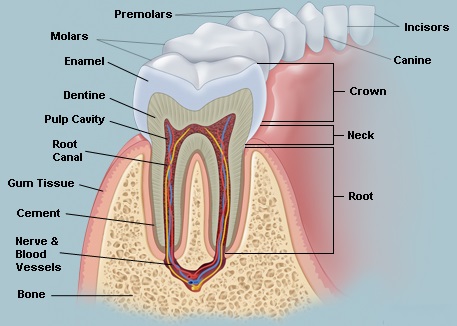



Dental Abscess (Toothache)
An abscessed tooth is an infection caused by tooth decay, periodontal disease or a cracked tooth. These problems can let bacteria enter the pulp (the soft tissue of a tooth that contains nerves, blood vessels and connective tissue) and can lead to pulp death. When pus builds up at the root tip in the jaw bone, it forms a pus-pocket called an abscess. If the abscess is not treated, it can lead to a serious infection in the jaw bone, teeth and surrounding tissues.
Symptoms of an abscess include:
An abscessed tooth can be treated with various treatments, depending on the severity of the infection. Here are some of the treatment methods a dentist may consider:
antibiotics, to destroy the bacteria causing the infection
drainage of the infection
cleaning the space between the tooth and the gum if the cause is from gum disease
root canal treatment if the abscess is caused by decay or a cracked tooth
Following good oral hygiene practices and routine dental exams will significantly reduce your risk of developing a tooth abscess. If your teeth experience trauma (become loosened or chipped), see your dentist as soon as possible.
Tooth Fracture
Your teeth are composed of four dental tissues. Three of them—enamel, dentin and cementum—are hard tissues. The fourth tissue—pulp, or the center of the tooth that contains nerves, blood vessels and connective tissue—is a soft, or non-calcified, tissue.

Enamel. Hard calcified tissue covering the dentin in the crown of tooth. Because it contains no living cells, tooth enamel cannot repair damage from decay or from wear. Only a dentist can correct these conditions.
Anatomical Crown. The visible part of your tooth. It is normally covered by enamel.
Gums (also called gingiva.) Soft tissues that cover and protect the roots of your teeth and cover teeth that have not yet erupted.
Pulp Chamber. The space occupied by the pulp—the soft tissue at the center of your teeth containing nerves, blood vessels and connective tissue.
Neck. The area where the crown joins the root.
Dentin. That part of the tooth that is beneath enamel and cementum. It contains microscopic tubules (small hollow tubes or canals). When dentin loses its protective covering (enamel), the tubules allow heat and cold or acidic or sticky foods to stimulate the nerves and cells inside the tooth, causing sensitivity.
Jawbone (Alveolar Bone.) The part of the jaw that surrounds the roots of the teeth.
Root Canal. The portion of the pulp cavity inside the root of a tooth; the chamber within the root of the tooth that contains the pulp.
Cementum. Hard connective tissue covering the tooth root, giving attachment to the periodontal ligament.
Periodontal Ligament. A system of collagenous connective tissue fibers that connect the root of a tooth to its socket.
Oral Bleeding
There are many reasons your gums could bleed.
In some cases, bleeding gums can be a sign of gingivitis, the early stage of periodontal disease. If your gums bleed easily or bleed when you brush, talk to your dentist about your oral health. Gingivitis is reversible and preventable.
If you’ve just started a new flossing routine, for instance, your gums may bleed at first as they get used to cleaning between the teeth. This usually goes away on its own in about a week. Some pregnant women develop a condition known as “pregnancy gingivitis,” an inflammation of the gums that can cause swelling and tenderness. Gums also may bleed a little when brushing or flossing. If you take blood thinners, these medications may cause your gums to bleed. Contact your physician if the bleeding does not stop quickly. Your gums could also be bleeding if you brush too hard. Use an extra-soft or soft-bristled toothbrush when brushing your teeth.
If your gums bleed regularly or enough to worry you, make an appointment with your dentist or physician. It could be a sign that something else is wrong.
Always remember to brush your teeth twice a day, floss once a day and schedule regular dental visits.